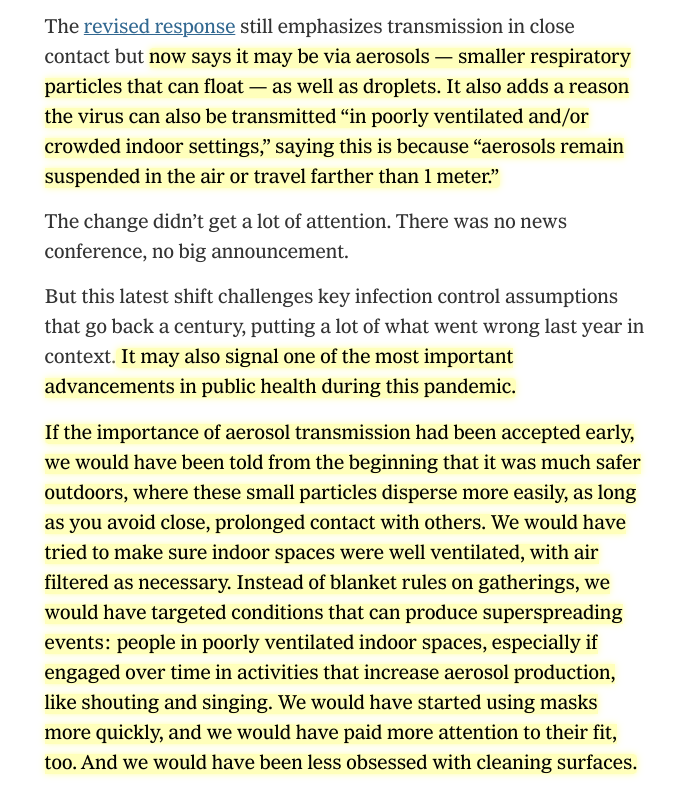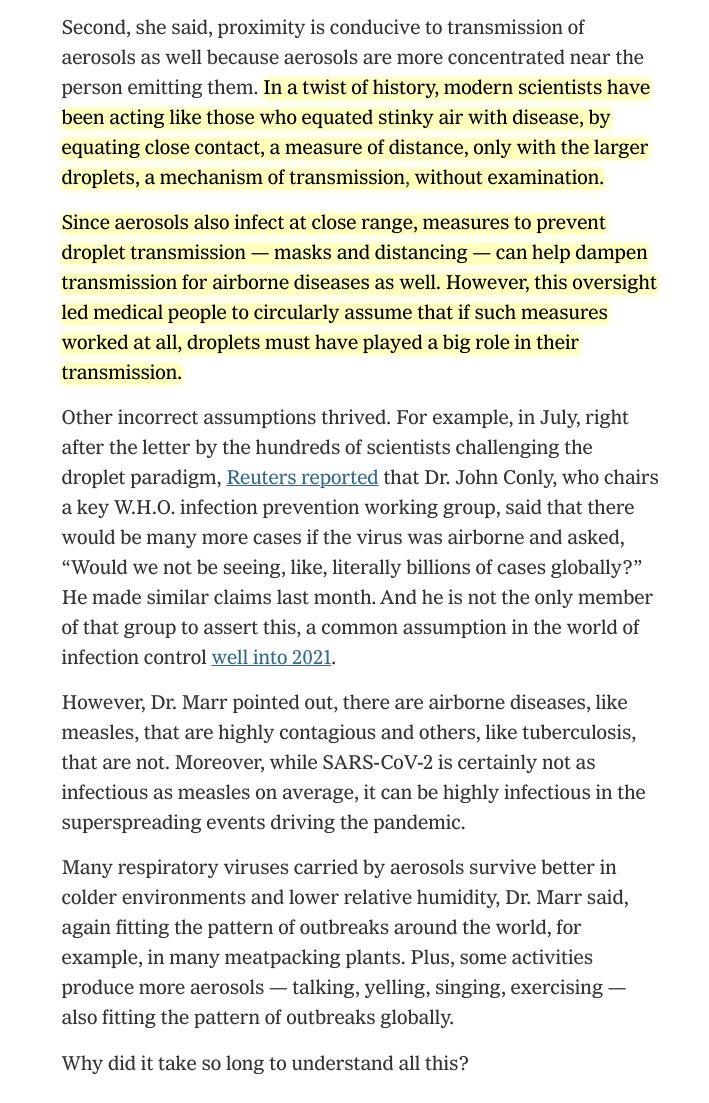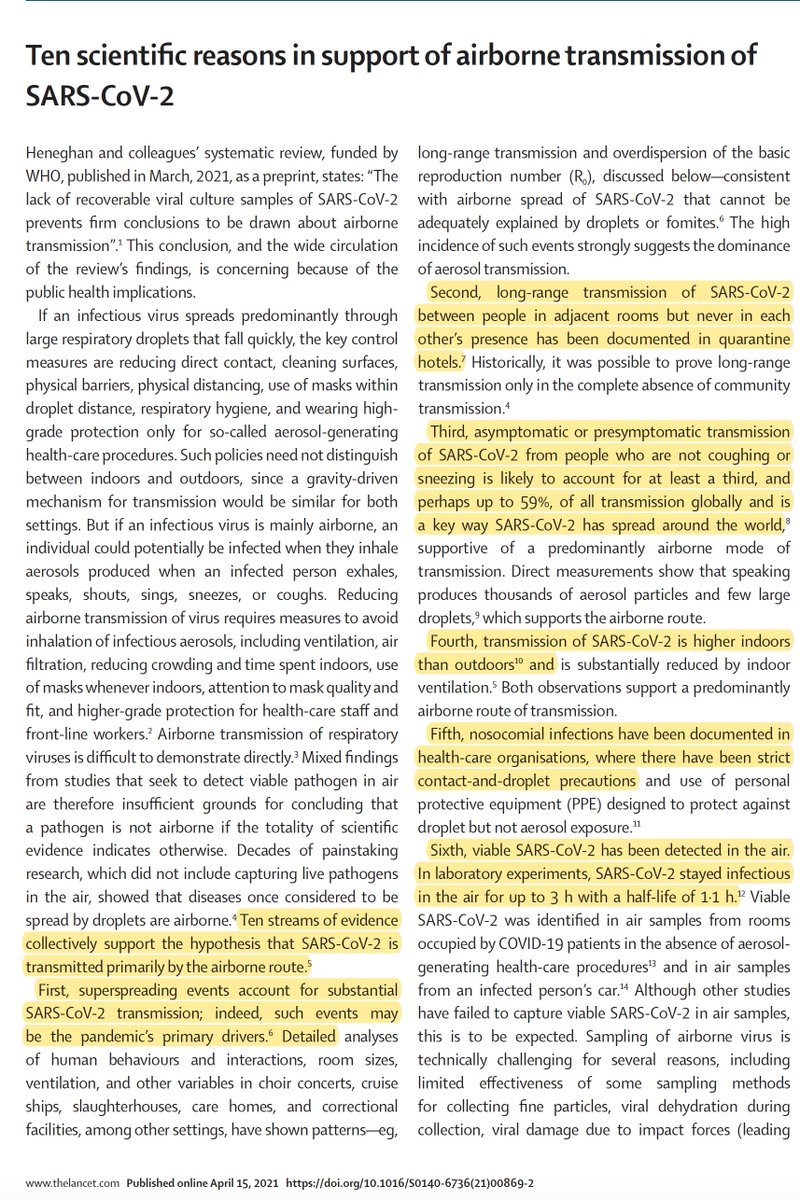The WHO just updated its page on how COVID-19 transmits. Those few sentences on aerosols represent one of the most crucial scientific advances of the pandemic. My NYT piece on the century-long history of the error, the year of delay—and what it means now. https://www.nytimes.com/2021/05/07/opinion/coronavirus-airborne-transmission.html">https://www.nytimes.com/2021/05/0...
This history goes back to scientists trying to get germ theory accepted and fighting (incorrect) folk theories of miasma—infection via stinky air—and they made some mistakes themselves along the way. Some froze into dogma. It took until this pandemic to, finally, start fixing it.
It& #39;s a huge advance, not a minor change. It explains so much of what went wrong and how to do better. We started with an incorrect theory of how COVID-19 transmits. One key error goes back a century. And it took a pandemic year to get to even this point. https://www.nytimes.com/2021/05/07/opinion/coronavirus-airborne-transmission.html">https://www.nytimes.com/2021/05/0...
It& #39;s a long piece—and honestly, maybe I have maybe 10% of just the narrative in there, and maybe 2% of the history—let alone the fascinating science. I& #39;m co-author on this peer-reviewed piece in The Lancet that explains some scientific details/issues. https://www.thelancet.com/journals/lancet/article/PIIS0140-6736(21)00869-2/fulltext">https://www.thelancet.com/journals/...
It is *really* important for the WHO, the CDC and all the public health agencies to publicize this and lead because there are also a lot of misconceptions—some stemming from the same errors. Masks and distance are still important, for example, but need more context to evaluate.
And... Wow. The New York Times is reporting that the CDC has just updated its descriptions of how COVID-19 is transmitted via aerosols. (Reading the CDC new version now). Eppure galleggia. https://www.nytimes.com/2021/05/07/health/coronavirus-airborne-threat.html">https://www.nytimes.com/2021/05/0...
Incredible week. First the WHO, now the CDC. It& #39;ll take work to have all this be heard, and correctly. Just today, I saw Canada is planning to close beaches "to protect against variants." It takes more than a few website updates to fix a year of messaging. https://twitter.com/nytimes/status/1390750809005203462">https://twitter.com/nytimes/s...
To get the significance of this, *just last week*, key UK infection control societies published a review with the same conflations/errors that CDC and WHO just moved towards correcting—and rated fomite and aerosol transmission (outside of medical procedures) as equally possible.
I want to add this here. Also, the story is really fascinating and much longer in terms of the sociology of science, standards of evidence, the scientific details and more, but we cut it to "only" about 5,000 words because that& #39;s already so long.  https://abs.twimg.com/emoji/v2/... draggable="false" alt="😁" title="Grinsendes Gesicht mit lächelnden Augen" aria-label="Emoji: Grinsendes Gesicht mit lächelnden Augen"> https://twitter.com/zeynep/status/1390766250775744512">https://twitter.com/zeynep/st...
https://abs.twimg.com/emoji/v2/... draggable="false" alt="😁" title="Grinsendes Gesicht mit lächelnden Augen" aria-label="Emoji: Grinsendes Gesicht mit lächelnden Augen"> https://twitter.com/zeynep/status/1390766250775744512">https://twitter.com/zeynep/st...
I have a growing databases detailing rules and restrictions around the world—to this day—that made sense from where we started—short-range respiratory droplets—but do not make sense at all, and are even counterproductive. Need to change that AND also emphasize what remains same.
Aerosol scientists kept telling me that plexiglass barriers might be making things *worse* by blocking ventilation. Just out in Science. Desk shields associated with *increased* illness risk in schools. Closing playground? Also uptick. So many upshots. https://science.sciencemag.org/content/early/2021/04/28/science.abh2939">https://science.sciencemag.org/content/e...
On that: the epidemiological record is clear. And the science explains why. Note that as I wrote, it’s not completely safe if you engaging close and prolonged contact among unvaccinated people. But it’s absolutely SO much safer. We need a very different approach to the outdoors https://twitter.com/bengardnernyc/status/1390777283858870275">https://twitter.com/bengardne...
Yes! Some of what we can try to do now, and for likely other respiratory diseases going forward, is not necessarily expensive, and some that is expensive is a better return for us than excessive hygiene theater and plexiglass and all the rest. And good for health in general! https://twitter.com/allanricharz/status/1390747339162324999">https://twitter.com/allanrich...
A @linseymarr thread from March 5, 2020. Look at how well it holds up. There are people across the world and across discipline working on all this, many before the pandemic, and in some countries they were listened to (early masking, cluster focus). https://twitter.com/linseymarr/status/1235641151249616896">https://twitter.com/linseymar...
I learned much of this first from a virologist and infectious disease specialist in Japan, Dr. Oshitani who had everything—aerosols, presymptomatic transmission, clusters—nailed by February of 2020. For purposes messaging, this is it, from March 2020: https://twitter.com/JPN_PMO/status/1244231002257383424">https://twitter.com/JPN_PMO/s...
The neat part is the update is because right after the article went live, CDC also updated its guidance. https://www.nytimes.com/2021/05/07/opinion/coronavirus-airborne-transmission.html">https://www.nytimes.com/2021/05/0...
Also I want to highlight this by @rkhamsi, which is one of the earliest pieces I know of in English on all this. March 14, 2020. Look how well it holds up as well, especially in highlighting the need to move beyond the dichotomies quickly. https://twitter.com/rkhamsi/status/1238807298673434625">https://twitter.com/rkhamsi/s...
The central statement of the group is: “The transmission of the SARS-CoV-2 viruses takes place almost without exception indoors.” ht @BernieCornfeld https://www.thelocal.de/20210412/danger-lurks-inside-german-aerosol-experts-say-covid-restrictions-should-target-indoor-areas/">https://www.thelocal.de/20210412/...
This isn’t exactly true though, for this. Once aerosol transmission is correctly understood, it actually *unlocks* effective mitigations, especially since SARS-CoV-2 is overdispersed (either superspreadering OR low transmission). Aerosol recognition shows us its chokepoints. https://twitter.com/tyschalter/status/1391386430572797957">https://twitter.com/tyschalte...
I just want to keep highlighting that there are very few confirmed outdoor transmission cases at all, and they are mostly in the context of prolonged *and* really close contact AND that the science of aerosol transmission makes it very clear why outdoors is so so much safer. https://twitter.com/joannateglund/status/1390681712682749952">https://twitter.com/joannateg...
My piece on the history and the context of the debate over aerosol transmission is out in print today in the New York Times. (Online is longer and linked below, print is shorter!): https://www.nytimes.com/2021/05/07/opinion/coronavirus-airborne-transmission.html">https://www.nytimes.com/2021/05/0... https://twitter.com/EricTopol/status/1391642044167196675">https://twitter.com/EricTopol...
So much gratitude to @avizvizenilman and @isaacscher who provided incredible research assistance. The piece was fact-checked within an inch of its life over many days, and it& #39;s the tip of an iceberg in terms of the research and documentation that went into it.
Look at this incredible thread by @jljcolorado on the history of aerosol denial/misunderstandings/errors. I put (what I could fit) to highlight this. There& #39;s something to say about individual conduct during all this—but also that this is a longer history. https://twitter.com/jljcolorado/status/1391111720526024708">https://twitter.com/jljcolora...
The history matters. Top medical journals still publish errors about aerosol size and biomechanics. Not individual malfeasance. The errors are in the textbooks. Medical doctors are not biophysicists or aerosol engineers. Dismissing relevant expertise has been, sadly, very costly.
The other part is how causal inference differs by field. Clinical practice rightly uses randomized trials (crucial for drugs and vaccines) but the clear point that the droplet theory didn& #39;t do a good job explaining the world as we observed it didn& #39;t get the attention it deserved.
Overlooked but key. Nothing about transmission in this pandemic makes sense except in the light of overdispersion. It alternates between contagious clusters and little to no transmission. This makes causal inference difficult. It fries our assumptions. https://www.theatlantic.com/health/archive/2020/09/k-overlooked-variable-driving-pandemic/616548/">https://www.theatlantic.com/health/ar...
Yes, around the world, to this day. And the constant overuse of bleach etc. is not just a waste of time and resources, it& #39;s genuinely unhealthy. "Stop over-disinfecting and start ventilating" has to be a loud campaign, led by WHO & public health agencies. https://twitter.com/Calamitatis/status/1391733545270497282?s=20">https://twitter.com/Calamitat...
Yes. Some of what we can do is easy/free. Some of it is not, and requires resources and trade-offs (sealed building are energy efficient). Filtering can be an option when dilution is not. Challenge is very real, but still should start from the right place. https://twitter.com/SeeTedTalk/status/1391739250291486727">https://twitter.com/SeeTedTal...
Yep. Overdispersed things can& #39;t be studied with methods not suitable for them. Example: information provided by non-events is asymmetric compared to info from events. Cluster-randomized trials—say for source control—can& #39;t easily get statistical power. Etc. https://twitter.com/DrPieterPeach/status/1391741852852756486">https://twitter.com/DrPieterP...
Let me highlight that excellent work has been happening all year, as well. Resistance to relevant expertise was a problem, but many key papers from this year are co-authored by people across disciplines. One interesting interdisciplinary panel today. https://twitter.com/VirusesImmunity/status/1391751814840717316">https://twitter.com/VirusesIm...
Excellent, rapid progress from the CDC, clarifying the tables that came with the aerosol update. https://twitter.com/linseymarr/status/1391863551132897285">https://twitter.com/linseymar...

 Read on Twitter
Read on Twitter












